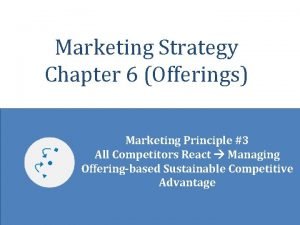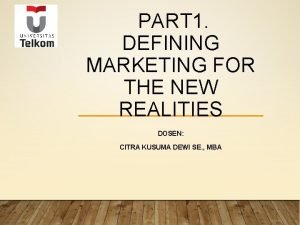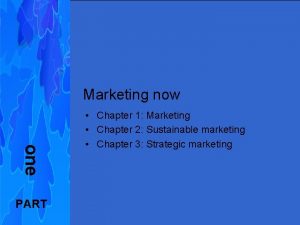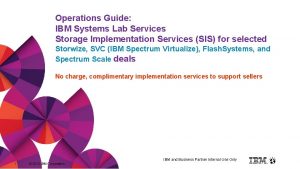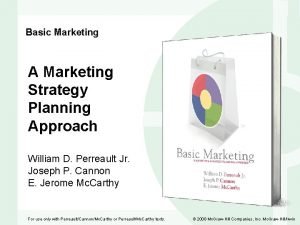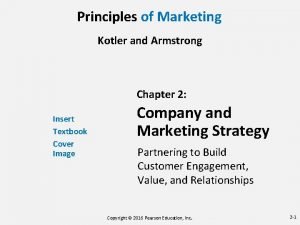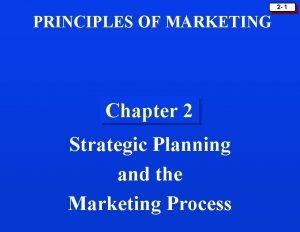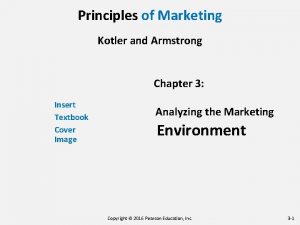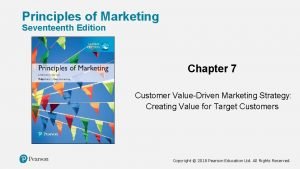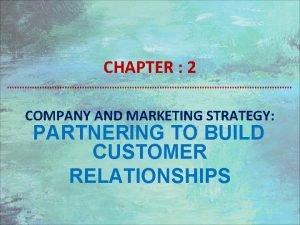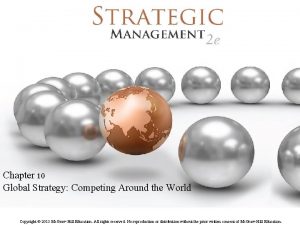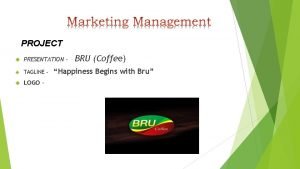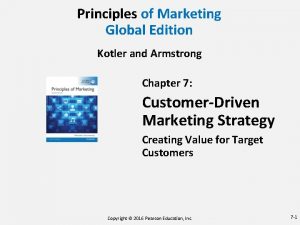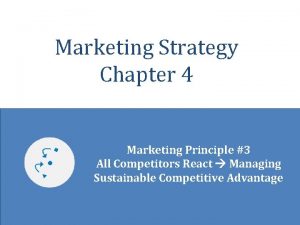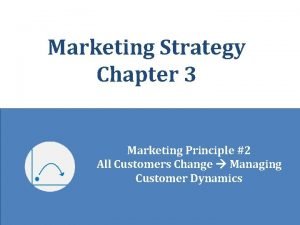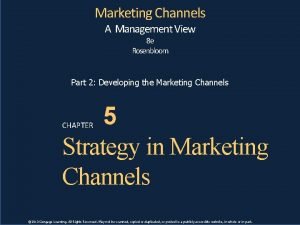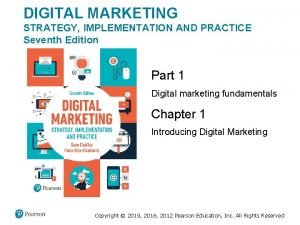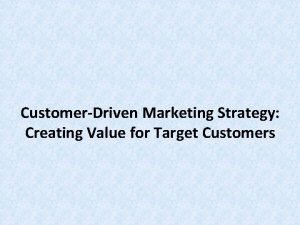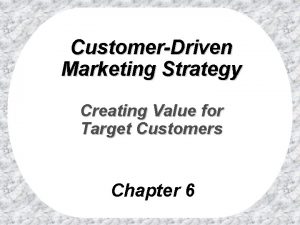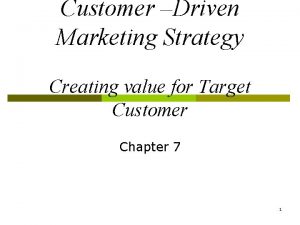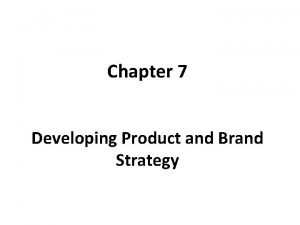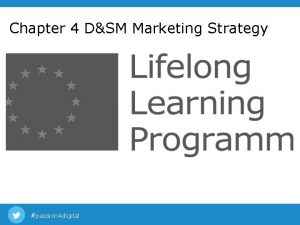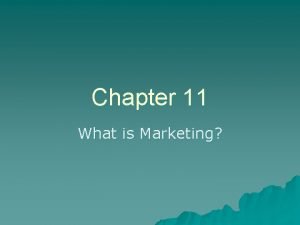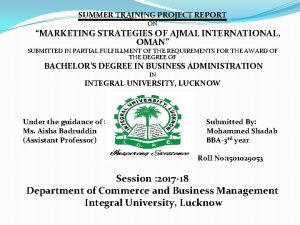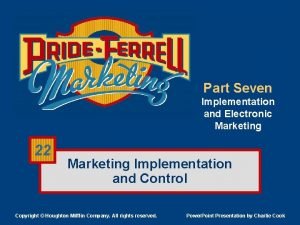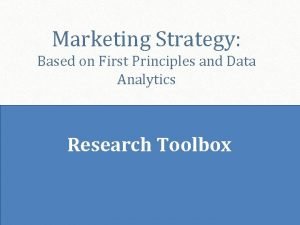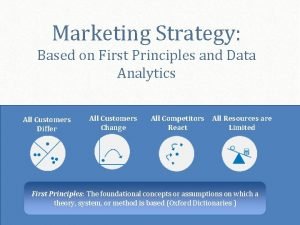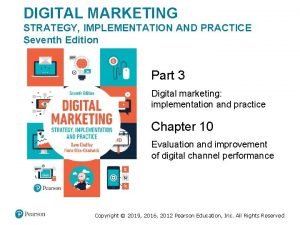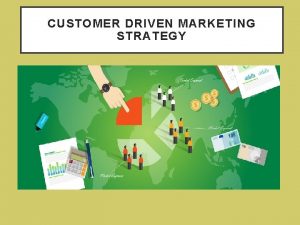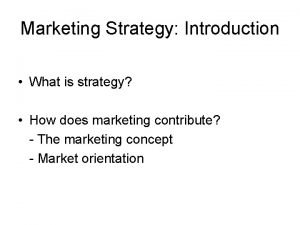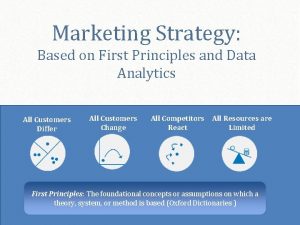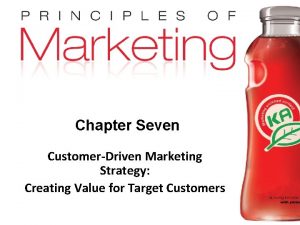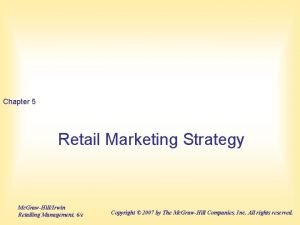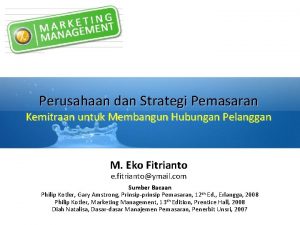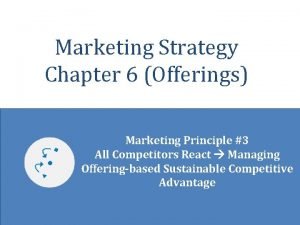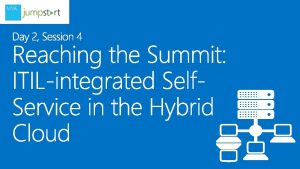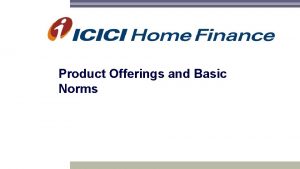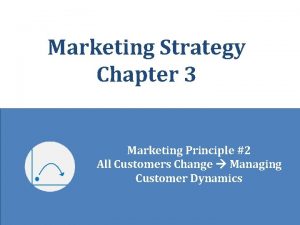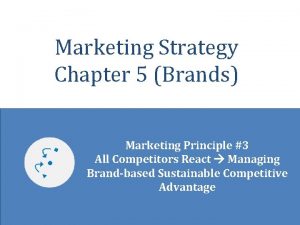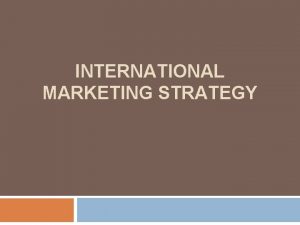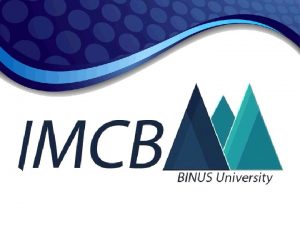Marketing Strategy Chapter 6 Offerings Marketing Principle 3










































































- Slides: 74

Marketing Strategy Chapter 6 (Offerings) Marketing Principle #3 All Competitors React Managing Offering-based Sustainable Competitive Advantage © Robert Palmatier 1

Agenda n Introduction n Offering and Innovation Strategies n n Developing Innovative Offerings n Repositioning and Disruptive Innovations n Conjoint Analysis Launching and Diffusing Innovation Strategies n Psychological, People, and Products Factors n Bass Diffusion Model Managing Offering-Based Sustainable Competitive Advantages Steps to Building Offering Equity Research Approaches to Designing and Launching New Offerings Takeaways © Palmatier 2

Developing an Innovative Offering is Critical to Many Firms’ SCA n GE is pursuing 100 “imagination breakthrough” projects to drive growth n “Innovation is the only way that Microsoft can keep customers happy and competition at bay” (Ballmer) n Today, innovation is the number one strategic priority at 40% of companies versus 19% in 2005 (BCG) n 86% of senior managers believe that “innovation is more important than cost reduction for long-term success” (Bain) n However: short-term business pressures often undermines innovation CEOs want returns from marketing in 6 -12 months Resources taken from long-term initiatives to hit short-term targets Accounting practices for market-based assets impact decisions © Palmatier 3 3

Innovation Offering n Innovative new offerings help firms build and maintain SCA and barriers to the competitive attacks that arise because competitors continually react to a firm’s success (MP#3) n Offering is a purposely broad term that captures both tangible products and intangible services provided by firms n Most offerings must be augmented by and linked to brands and relationships to ensure the firm’s SCA, because it generally is relatively easy for competitors to copy offerings, given enough time and money © Palmatier 4

Example: Dell (US) n Dell operates in a technology space, but perhaps its most compelling innovation has been the ordering and logistics processes that it introduced in the market n Building-to-order “semi-custom” computer products and selling them directly to consumers online was radical when it first appeared n Dell’s SCA did not depend on its design or manufacturing competencies; Dell even outsourced the manufacturing. Rather, the SCA came from an offering in which it built computers to order, sold them online, and significantly cut costs by avoiding the expenditures associated with maintaining storefronts and inventory or suffering obsoletion costs © Palmatier 5

What Is Innovation? n Innovation is the “creation of substantial new value for customers and the firm by creatively changing one or more dimensions of the business” n Key Aspects of Innovation Broader than product or technology innovation Must generate new value for customer and seller Involves change leading to differentiation and SCA How did Starbucks, Dell, and IPod create value and SCA? © Palmatier (Sawhney, Wolcott, and Arroniz) See 12 Different Ways for Companies to Innovate 6

Many Aspects of the Offering Can be Innovated n n There are many different ways a firm can innovate; it helps define the innovation space according to what, who, how, and where aspects Change what the firm offers, in line with a traditional view of new product or service innovation Changing who the customer is represents another route that involves innovations related to customers, experiences, and value capture Changing how you sell to customers pertains to the processes, organizations, and supply chains that a firm uses Changing where to sell to customers comprises presence, networking, and brand innovations Innovation Rader © Palmatier Captures many different ways a firm can innovate; helps define the innovation space according to what, who, how, and where 7

Innovation Radar Brand Leverage the brand H into new W Networking markets Interconnections as a strength E ER W H AT Develop new products or Platform services Use interchangeable designs Presence Solutions Change where products are sold Provide a total solution Organization Change firm structure Supply chain H Changing what the firm offers Value capture Change how customers pay Experience Change supply customer chain Processes Customer interactions Change customers to operating target processes OW Changing how to sell to customers Offering W HO Changing where to sell to customers Changing who the customer is Adapted from Sawhney, M. , Wolcott, R. C. , & Arroniz, I. (2006), “The 12 Different Ways for Companies to Innovate, ” MIT Sloan Management Review, Vol. 47 (3), p. 75. © Palmatier 8

Starbucks Brand Offering (WHAT) Solution Networking Customers (WHO) Presence (WHERE) Supply Chain Organization © Palmatier Platform Customer Experience Process (HOW) Value Capture 9

Walmart © Palmatier 10

Innovation Radar Exercise: Take a Few Minutes and Develop Innovation Ideas 1. Offering: Develop new products or new services n Team exercise (IPOD) 2. Platform: Design modular platforms and strategic control points (Nissan) n Think of one way to innovate 3. Solution: Solve end-to-end customer problems for the assigned radar (John Deere) dimension 4. Customer: Discover unmet customer needs or underserved segments (DIY) n Use one of the companies 5. Experience: Rethink how customers interface with you (IKEA) below: 6. Value Capture: Redefine how you get paid Your firm (Google) T-Mobile 7. Processes: Innovate in your core operating processes (Progressive) Microsoft 8. Organization: Change form, function or scope Alaska Airlines (IBM, Arrow) Nordstrom 9. Supply chain: Rethink sources (Dell) 10. Presence: Innovative points of presences (Starbucks at airport) 11. Networking: Integrated offering, leverage others (Otis elevator) 12. Brand: Leverage the brand into new domains (Virgin) © Palmatier 11 11

Benefits of Innovation and Offering’s Equity n By building offering equity, an innovative firm can make it more difficult for competitors to encroach on its business n Offering equity refers to the core value that the performance of the product or service offers the customer, absent any brand or relationship equity effects n New offerings often motivate customers to switch from competitors to the innovative firm, to gain access to the new product n New offerings also can help the firm acquire new customers or enter new markets when they offer similar performance but at a lower price n Offering new and innovative products tends to enhance the firm’s brand, even if customers don’t buy the new offering © Palmatier 12

Example: Blue. Scope (Australia) n Blue. Scope is an international supplier of steel products based in Australia n Patented groundbreaking Castrip process that produces 70% less greenhouse gas emissions and requires 10% of the floor space of conventional steel mills n To protect its offering equity from foreign competitors, the innovation is patented. The protected innovation is highly anticipated to enhance Blue. Scope’s positioning as a leading global supplier of steel products and solutions. © Palmatier 13

Example: Tom (the Netherlands) n Netherlands-based electronics company Tom launched its first navigation product in 2002 when there were relatively few firms focusing on this area n Through quick innovation and responding to customers’ needs, Tom was able to stay ahead of its competitors and build itself into a worldrecognized brand that, by 2007, had more than 50% of the market share in Europe for navigational devices n However, GPS-enabled smartphones have now disrupted Tom’s once strong position in this application. © Palmatier 14

Agenda n Introduction n Offering and Innovation Strategies n n Developing Innovative Offerings n Repositioning and Disruptive Innovations n Conjoint Analysis Launching and Diffusing Innovation Strategies n Psychological, People, and Products Factors n Bass Diffusion Model Managing Offering-Based Sustainable Competitive Advantages Steps to Building Offering Equity Research Approaches to Designing and Launching New Offerings Takeaways © Palmatier 15

Offering and Innovation Strategies n Marketing contributes to and defines offering and innovation strategies in two main ways: 1. It helps the firm develop innovative offerings by collecting customer input and forecasting customer and market trends, so that the firm can understand the trade-offs among potential product attributes 2. Marketing is responsible for launching the new offering to customers to generate sales with acceptable profit levels n Many good products fail to achieve their set financial objectives due to poor product launches n Extensive efforts go in to test marketing and understanding the factors that will influence whether customers adopt a new offering and increase the likelihood of a successful launch © Palmatier 16

Developing Innovative Offerings n Most firms rely on a stage-gate development process to increase the speed of their offering development and enhance their likelihood of success, while also reducing development costs n A stage-gate model divides the development process into a series of steps or stages n Each project gets evaluated, on multiple dimensions, by independent evaluators in each stage n This method thus helps ensure effective development approaches through several elements © Palmatier 17

Stage-Gate Design Review Process for Effective Product Development Concept and Definition Design and Development Validation and Production Final Audit Initial ideas New Product The concept and definition stage consists of an initial screening of all potential ideas, concept assessment, project definition, and feasibility assessment. The design and development stage consists of product and process design and development. Financial feasibility considerations also are pertinent, including testing of price points and customer acceptance. The validation and production stage consists of continued market launch planning and product manufacturing and process validation. It also may include test marketing and evaluation of launch plans. The audit stage consists of final product and product assessments. It often includes some reflection on the previous steps. 18

Example: Tata Motors (India) n Tata Motors innovated the Nano, the cheapest car in the world, launched in 2009 at a sale price of just $2, 000 n Most car manufacturers use a sedan chassis to begin building new models; Tata challenged the conventional wisdom and started with a blueprint featuring a scooter’s backbone n The ultimate product cost less to build and thus was affordable in the Indian market, but perhaps even more important, it turned out to be better suited to busy Indian traffic patterns, which require quick and frequent maneuvering © Palmatier 19

Repositioning Strategies n An innovative offering can result from dramatically repositioning an existing offering, such as removing some features or adding others, so that the total offering appeals to a different customer segment with a “new” value proposition n The advantage of this strategy is that it generally does not require a new technology or invention, and marketers thus can to take the lead in these efforts n Red Ocean markets—thus named to reflect the metaphor of blood in the water—are very competitive and populated by “sharks” fighting over the same customers n To pursue more disruptive repositioning strategies, firms instead can seek out Blue Ocean markets, a metaphor reflecting the blue hue of the deep ocean waters that are far from land © Palmatier 20

Red vs. Blue Ocean Innovation Approach n Classic STP focuses on red ocean strategies and incremental innovation Known market space, competitive rules, and industry boundaries (lifecycle mindset) Product mature and become commodities Can be managed, tested, and analyzed n Disruptive positioning focuses on the blue ocean Market space does not exist (unknown boundaries) Demand is created rather than fought over (often no direct competition) Hard to test, more of an art, often requires intuition, high risk © Palmatier (Kim and Mauborgne) 21 21

Example: Cirque du Soleil (Canada) n Cirque du Soleil removed two familiar features associated with traditional circuses like Ringling Bros. and Barnum & Bailey: large animals (e. g. , elephants, lions) and big name stars (e. g. , The Flying Wallendas, Antoinette Concello). Then it added theater-like productions, each with a different theme and original music n Cirque du Soleil raised prices and redefined their target market. Rather than children and families, it sought to appeal to adults, couples on dates, and business clientele n Cirque du Soleil removed substantial cost drivers from the innovative offering, added new and unexpected features, and developed a new target market © Palmatier 22

Defining Characteristics of Blue Ocean Initiatives n Don’t use competitors as the benchmark n Rejects tradeoff of value versus cost n Redefines value proposition Example: Cirque du Soleil n n See Blue Ocean Strategy Reading Reduced cost-animals and stars Added value-theater like production with theme, original musical n Often first mover develops barrier to imitation Economies of scale (Wal-Mart, Fed-Ex) Brand (Cirque du Soleil, Fed-Ex) Switching costs (Quicken) © Palmatier 23 23

Comparison of Red and Blue Ocean Strategies Red Ocean Strategies Blue Ocean Strategies New offerings are brand line extensions, representing incremental innovations (uses STP processes) Less numerous but more radical and repositioned offerings, focused on creating new markets Account for the majority of sales but earn lower relative profit levels Success generates higher profit levels High competitive rivalry in existing markets Creates a new market with less competitive rivalry Must beat existing competition Often transforms the image of competitors’ brand features, such that they become a negative attribute in the new market Attempts to capture a portion of existing Attempts to create new market demand © Palmatier 24

New Technology – Based Innovation Strategies n A technological innovation can undermine a firm’s leadership position in a market, even if that firm is doing everything else well n To describe the process and ultimate outcomes of innovative technologies, Clayton Christensen has offered the framework, which highlights two main categories of these technologies Sustaining technologies are well understood and typically exploited by market leaders, which produce continuous, incremental improvements over time Disruptive technologies accordingly present highly different price and performance characteristics or value propositions © Palmatier 25

Sustaining Versus Disruptive “Technological” Innovation n Companies doing everything well can lose their leadership position due to failing to manage disruptive innovations (Polaroid, Xerox, DEC) n Sustaining technologies improve performance of established products along dimensions valued by mainstream customers in major markets Products often overshoot customer needs Processes support incremental product improvements (lower risk) n Disruptive technologies result in “worse” product performance, at least in the near term Brings to market a different value proposition than available previously Underperforms established products in mainstream markets Typically cheaper, simpler, smaller, or more convenient to use Small off-road motorcycles and transistor radios Eventually are good enough (servers vs. mainframes) © Palmatier (Christensen) 26 26

Performance Features Sustaining Versus Disrupting Technical Innovations Disruptive technology With its very different price and performance characteristics this technology often improves very quickly. Incremental enhancement Sustaining technology This well-understood technology will lead to continuous, incremental improvements over time. High-End Customers Incremental enhancement Low-End Customers Time Adapted from Christensen, C. M. (1997), The Innovator's Dilemma: When New Technologies Cause Great Firms to Fail. (Boston, Mass. : Harvard Business School Press) © Palmatier 27

Incumbents Usually Win the Battles of Sustaining Innovation Performance Measure Digital to Optical MOST DEMANDING CUSTOMERS Caller ID MAIN STREAM CUSTOMERS Analog to Digital LEAST DEMANDING CUSTOMERS Time Source: Christensen © Palmatier (Christensen) 28

New Entrants Usually Win the Battles of Disruptive Innovations Performance Measure Digital to Optical MOST DEMANDING CUSTOMERS Caller ID MAIN STREAM CUSTOMERS Analog to Digital LEAST DEMANDING CUSTOMERS VOIP Time © Palmatier (Christensen) 29

Mini-Mills Took 50% Share by Starting with Low-End Rebar STEEL QUALITY 25 -30% -- 55% EEL ET ST SHE L – 22% L STEE CTURA STRU 15% – 8% S & ROD R A B , ANGLE 12% R – 4% REBA 7% % IN TONS 1975 © Palmatier 1980 1985 (Christensen) 1990 TIME 30

Transistors Were First Used in New Markets Performance tubes Different Performance Measure m Vacuu ssors e roproc c i M ip r ansisto Tr h mory c e M ip Time IC ch Time Non-consumers or Non-consuming contexts © Palmatier Sonotone 1952 Sony 1955 31

Disruptive Innovations Occur in Either Low-End of Existing or in New Markets Low End Disruptions New Market Disruptions n Nucor’s steel mini-mills n Bell telephone (telegraph) n Vanguard’s index mutual funds n e. Bay online marketplace n Dell’s direct-to-customer business model n Transistor radios Why? n Cannot compete with existing, sustaining products n Leaders want to incorporate new technologies into existing markets and products © Palmatier (Christensen) 32

Why do Market Leaders Fall into This Trap? n Companies find it difficult to invest in disruptive innovations – lower-margin opportunities that their customers don’t want n Growth targets bias firm’s toward larger markets n Markets for disruptive innovations cannot be quantified, which biases decision making n Competition leads to oversupplying performance relative to what customers want n Solution: set up an autonomous organization tasked with building an independent business around the disruptive innovations (e. g. , H&R Block Tax Cut Software in response to Turbo Tax) © Palmatier 33 33

Overall: Must Manage Portfolio of Red Ocean/Sustaining and Blue Ocean/Disruptive Innovations n Ensure business is conducting classical STP and stage-gate innovation Constant flow of new products (incremental) Need uncompromised customer/competitive input n Develop a forum/process to enable/manage radical and disruptive innovation Challenge managers to change the game Radical changes to offering and new markets n Disgruntled customers (lost customers) Offsite scenarios Outsource, partners, alliances, acquisitions Hire outsiders from different industries Track potentially disruptive technologies, use internal “start ups” n © Palmatier 34 34

Conjoint Analysis Helps Make New Offerings “More” Successful n Product superiority drives financial success Largest predictor of new product success Good designs are 5 times more likely to succeed than poor designs n Product design requires making tradeoff decisions (price, performance, size, location, features…) n Conjoint analysis: process for determining the “unit-less” tradeoff among attributes and set of attributes that maximizes appeal (sales, share) © Palmatier 35 35

DAT 6. 1 Conjoint Analysis Description With a conjoint analysis, marketers can design and develop new products by thinking of products as bundles of attributes, then determining which combination of attributes is best suited to meet the preferences of customers. How it Works © Palmatier When to Use It • To identify product attribute trade-offs that customers are willing to make for a new product. • To predict the market share and impact of a proposed new product (i. e. , bundle of attributes). • To determine the amount that customers are willing to pay for a new product

DAT 6. 1 Conjoint Analysis Example A smartphone manufacturer wants to design a new phone for its target demographic. The main product attributes the manufacturer wants to focus on are camera resolution quality, screen size, and price. The manufacturer also wants to understand customers’ willingness to pay for the new smartphone. Thus, it designs a conjoint study for 250 customers to provide a product rating score (0 = least preferred, 100 = most preferred) for eight alternative smartphones, according to their price, camera resolution, and screen size. One of the eight products is provided here for illustration: How likely are you to buy this smartphone? (Use a scale from 0 to 100, where 0=“definitely will not purchase” and 100 means “definitely will purchase”. ) Price $500 Camera Resolution 5 MP Screen size 2. 5 inches Your Rating (0 to 100, where 100 is most likely to buy): With the rating scores from the 250 customers, the manufacturer can apply the conjoint formula and estimate the part-worth utilities associated with each product attribute. Let’s say that our hypothetical customers, reasonably, prefer the $500 smartphone more (partworth = 25) than the $600 option (part-worth = 0). They also want an 8 MP smartphone (part-worth = 10) rather than a 6 MP one (part -worth = 0) and a 6. 5 -inch screen (part-worth =20) more than a 5. 5 -inch one (part-worth = 0). The part-worth difference between the 5. 5 - and 6 -inch phone options (20 – 0 = 20) is twice as great as the difference between the 8 and 6 MP versions (10 – 0 = 10), so screen size appears twice as important as camera resolution quality. The part-worth difference between the $500 and $600 smartphones was 25 (25 – 0 = 25), which implies that each part-worth unit is worth $4 ($100 = 25 units, or 1 unit = $4). Noting that the part-worth difference between the 5. 5 - and 6 -inch phone options was 20 units, the manufacturer can estimate that customers are willing to pay $80 (i. e. $4 x 20 units = $80) more for a 6 -inch screen than for a 5. 5 -inch version. Thus, this manufacturer should produce a phone with 6 MP camera quality, a 6 -inch screen size, and a price that is $80 more than the base price of $500. © Palmatier 37

Conjoint Analysis Process 1. Design study n Select attributes and levels (range and #) n Develop bundles (< 16 optimal) 2. Collect data from respondents n Design data collection instrument n Calculate partworths 3. Evaluate product design options © Palmatier n Evaluate market simulations n Evaluate different choice rules 38

Designing an EMBA Program Attributes n n Cost of Program (2 levels) Rigor of Program (2 levels) Location of Program (3 levels) Prestige of Program (2 levels) Cost of Program n n More than $20, 000 per year Less than $20, 000 per year A total of 24(2 x 2 x 3 x 2) different programs can be developed from these options! Location of Program n n n Rigor of Program n n Requires more than 10 hrs/week outside of class Requires less than 10 hrs/week outside of class © Palmatier More than 30 miles from home Between 10 and 30 miles from Within 10 miles of home Prestige of Program n n Top 10 ranked business school Not top 10 ranked business school 39 39

Collecting EMBA Ratings Data n Model generates bundles n Each respondent rates each bundle from 0 to 100 on likely to buy this offering © Palmatier 40 40

Partworths Computation and Interpretation n n Understanding partworth utilities (for each respondent): Least favorable level in each attribute is 0 Most favorable level across all attributes sum to 100 Can compare relative importance across attributes and respondents Best product for customer 1: Less than $20, 000 per year, requires more than 10/hrs/week work outside of class, between 10 and 30 miles from home, and is a top ranked business school. Ranking is most important and is over 12 times more important than cost (< or > 20 k$). © Palmatier 41

Using Conjoint Analysis to Evaluate Strategic Alternatives n Enter alternatives and/or competitive offerings into model n Can also enter market share of any known offerings to “tune” model © Palmatier 42 42

Model Estimates Market Share of Each Offering for Different Decision Rules Market Share by Offering Decision Rules First choice Share of preference Logit choice Cheap-N-Easy MBA Flashy MBA Value MBA 5% 72. 5% 22. 5% 11. 8% 50. 2% 38. 0% 15% 48. 6% 36. 4% § First choice rule: each customer selects the product that offers him/her the highest utility among the competing alternatives § Share of preference rule: customer selects each product with a probability that is proportional to the utility of that compared to the total utility derived from all the products in the choice set § Logit choice rule: alternative to share rule by using an exponential weighted utility © Palmatier 43

Mark. Strat Conjoint 1: Relative Importance Across Attributes (by segment) n Chart shows the relative importance of price and the three physical attributes that are perceived as most important (sums to 100) n Insight into most important attributes per segment © Palmatier 44 44

Mark. Strat Conjoint 2: Utility of Attributes Adopters n Chart show the utilities attached to four levels for given attribute n Utilities are measured on a scale from 0 (very low utility) to 100 (very high utility) n Results are broken down by segments n Insight into ideal value of attribute for segment Resolution © Palmatier 45 45

Agenda n Introduction n Offering and Innovation Strategies Developing Innovative Offerings n Repositioning and Disruptive Innovations n Conjoint Analysis Launching and Diffusing Innovation Strategies n Psychological, People, and Products Factors n Bass Diffusion Model n Managing Offering-Based Sustainable Competitive Advantages Steps to Building Offering Equity Research Approaches to Designing and Launching New Offerings n Summary n Takeaways © Palmatier 46

75% of Products Launched End Up Failing to Meet Objectives n Failure to provide large enough perceived benefit (poor development) n No differential advantage (Ben. Gay Aspirin) n Price versus performance (Apple Newton) n Poor product launch (slow diffusion) n Poor targeting of new product (Earring Ken) n Poor positioning of new product (Breakfast Mates, with warm milk and spoon) n Competitive response (Betamax and VHS) © Palmatier 47

Example: Kellogg’s (US) n Launched Breakfast Mates – a single serving of breakfast cereal, a spoon, and a serving of pasteurized milk that did not require refrigeration n Kellogg’s positioned the innovation as a solution for harried parents who wanted to give their children breakfast in the morning but were often rushing out the door to make it to school on time n Positioning was ineffective, because Kellogg’s failed to realize that parents hated the idea of giving their children a product that would enable them to spill milk all over the back seat of the car © Palmatier 48

Some Relevant Consumer Psychology on Persuasion n Social proof: looking at others is a way we determine what to do (Jonestown, testimonials) More people → larger belief it is correct More similar people → larger impact on behavior n Authority: we have a deep-seated sense of respect for authority and status (Mercedes vs. Ford study) n Scarcity: things seem more valuable when their availability is limited n Prospect theory: describes person’s perceived value for an objective gain or lost © Palmatier 49 49

Understanding Prospect Theory Current Wealth State Or “Status Quo” Objective Losses Subject Value (i. e. Psychological Impact) V (+) - $200 Objective Gains + $600 V (-) 1) Relative to reference point 2) Decreasing marginal sensitivity 3) Loss aversion © Palmatier Endowment effect: people value things in their possession more than when they don’t have the item. Effect of loss of item is larger than the gain (electric car). 50

Implications of Prospect Theory n Adoption is often very slow Especially, if consumer has to give something up (endowment effect) n Developers’ curse Employees often use new product and integrate new features into their offering (increases “value” of feature) as compared to consumers who haven’t used product Results in a 9 x difference in perceived value of feature n Some example launch strategies Eliminate the old (US versus Canadian 1$ coin) 10 x improvement to make the benefit overwhelming Seek out new to category customers (not endowed with existing features), Kodak 10$ camera © Palmatier 51 51

Launching and Diffusing Innovative Offerings n To explain new offerings’ diffusion rates, it can be informative to classify consumers into groups, according to their propensity to adopt new products and which persuasive arguments will prompt them to adopt n According to Geoffrey Moore, the adoption lifecycle of an innovative offering suggests five groups of potential users: Innovators are the first to adopt, often before the new offering even is officially launched Early adopters see the benefits of the new technology and are willing to adopt it after just a few references The early majority consists of much more pragmatic consumers, who need to be convinced that the new product really works Both of the last two groups, late majority and laggards, also want more evidence, but they are especially hard to persuade © Palmatier 52

Crossing the Chasm: Adoption Lifecycle Crossing the Chasm New product launches fail if the firm has not prepared to sell to early majority customers by the time it runs out of early adopters. Categories of Product Adopters Innovators First to adopt a new offering; actively seek new technologies Early Adopters Perceive the benefits of the new technology and are willing to buy with just a few references Chasm Gap between early adopters and early majority Early Majority More pragmatic, such that they must be convinced that the new product really works Late Majority Demands even more evidence of the product’s functionality and are harder to persuade Laggards Need the most evidence to persuade Adapted from Moore, G. A. (2006), Crossing the Chasm: Marketing and Selling Disruptive Products to Mainstream Customers, 1 st rev. ed. , (New York: Collins Business Essentials) © Palmatier 53

Failing to “Cross The Chasm” is Common Barrier to Success n Firm takes on more visionaries than it can handle n Cannot take on more custom projects, but no pragmatists ready to buy n Early market becomes saturated, and revenue growth tapers off or declines Key personnel become disillusioned Venture capital well begins to run dry n Marketing strategies that lead to success in selling to visionaries actually hinder success in selling to pragmatists n The adoption lifecycle approach clearly and systematically integrates aspects of both MP#1 and MP#2 See Marketing Input and Innovation Strategy reading for startups © Palmatier 54 54

Strategy to Cross the Chasm and Beyond 1. The Bowling Alley: n n 2. The Tornado: n n n 3. New product gains acceptance from niches and extends through a common platform Each niche requires expertise in that vertical market Market coverage propagates to neighbors and extends references Focuses marketing resources Period of mass-market adoption when the general marketplace switches over to the new technology Driven by application that provides compelling benefits to mass market: the “killer app” Requires strong operational excellence to keep up with demand Main Street: n n © Palmatier Market growth stabilizes Focus on cross-selling and upgrading to existing customers 55 55

Product-Based Factors that Influence Innovation Diffusion n Another long stream of research, starting with Everett Rogers, shows that specific product characteristics can capture 40– 80 percent of the variation in the speed with which offerings diffuse n Changing each of the following five factors can alter the rate of product diffusion, all else being equal 1. 2. 3. 4. 5. © Palmatier Relative advantage Compatibility Complexity Trialability Observability 56

Besides Psychology and People, “Product Factors” Determine the Rate of Diffusion 1. Relative Advantage: degree to which an offering is perceived as being better than the ideas it supersedes n n n Economic: cost, price See Note on Innovation Status, prestige, etc. Diffusion: Roger's Five Necessary but not sufficient (i. e. , new keyboard)Factors 2. Compatibility: degree to which an offering is perceived as consistent with existing values and experiences © Palmatier n Often must break habits, perceptions, beliefs n Plastic wine corks, Ti. VO 57 57

49% to 87% of the Variance in Rate of Adoption is Explained by 5 Factors 3. Complexity: degree to which an offering is perceived as relatively difficult to understand/use n Education is key (online banking) n Speed of Google 4. Trialability: degree to which an offering may be experimented with on a limited basis n Free samples, demo, test drive n Especially salient for high cost, time, risky products 5. Observability: degree to which the results of an offering are visible to others n Especially salient for status products n Can be negative (parking by a “men’s club”) © Palmatier 58 58

STP/BOR Strategies Should be Adapted Based on 3 Ps (Psych, People, Product) n Segmenting and Targeting Strategies Focus on vertical markets, intra-segment communication, no takeaways, large relative advantage (10 x) Low end and/or new markets for disruptive innovations Target beachheads for bowling alley effect Select segments where “ 5 factors” are best n Positioning Strategies Make offering compatible to existing offering Education and simplicity are key to messaging Free samples, reduce risk, use warranty and trial periods Enhance visibility of users, testimonials n Migration Strategies (Visionaries to Pragmatists) How to persuade gate keepers Building references and testimonials © Palmatier 59 59

But, Remember That Being First is Not a Guarantee of Success n 65 year historical study on impact of market entry Failure rate of pioneers is 47% Pioneers are ultimate leaders in only 11% of categories (10 years later) n First mover advantage is trumped by followers who are better. Best beats first. n Being a pioneer without the basis for sustainable competitive advantage is a trap! © Palmatier (Tellis and Golder) 60

What Company is This? Quotes from Business Publications/Newspapers in 1960 “World’s biggest chain of highway restaurants; Pioneer in restaurant franchising; Most strongly entrenched actor and highest quality; Most fabulous success story in restaurant chains” © Palmatier 61

Psychology, People, and Product Factors Determines Product Diffusion © Palmatier 62

Bass Diffusion Model for New Product Adoption Capture Multiple Factors (3 Ps) n Mathematical model used to forecast the rate of consumer adoption Potential nt = p ´ Remaining Innovation Effect + q ´ Adopter Proportion ´ Remaining Potential Imitation Effect nt = number of adopters at time t (Sales) p = “coefficient of innovation” (propensity to adopt independent of # of previous adopters) q = “coefficient of imitation” (propensity to adopt as a function of number of adopters) # Adopters = n 0 + n 1 + • • • + nt– 1 Remaining Potential = Total Potential (N) – # Adopters © Palmatier 63 63

Sum of Innovators and Imitators Yields Model for New Adopters © Palmatier 64

Estimating the Parameters of the Bass Model n Use historical data n Use analogous products Product/ Technology B&W TV Color TV Room Air conditioner Clothes dryers Ultrasound Imaging CD Player Cellular telephones Microwave Oven Hybrid corn Home PC © Palmatier Innovation parameter (p) Imitation parameter (q) 0. 065 0. 021 0. 010 0. 073 0. 003 0. 028 0. 005 0. 018 0. 000 0. 003 0. 335 0. 583 0. 454 0. 389 0. 506 0. 368 0. 506 0. 337 0. 798 0. 253 Van den Bulte and Stremersch (2004) suggests an average value of 0. 03 for p and an average value of 0. 42 for q 65 65

Example: Forecasting Direc. TV n Used Bass Diffusion model Market size estimate from customer survey Diffusion parameters estimated from managerial judgments and analogous products (cable TV) n Results: Five year forecasts made 3 years before launch were, on average, -16% below actual Forecast justified earlier launch of a satellite for expanded transmission capability © Palmatier 66 66

Agenda n Introduction n Offering and Innovation Strategies Developing Innovative Offerings n Repositioning and Disruptive Innovations n Conjoint Analysis Launching and Diffusing Innovation Strategies n Psychological, People, and Products Factors n Bass Diffusion Model n Managing Offering-Based Sustainable Competitive Advantages Steps to Building Offering Equity Research Approaches to Designing and Launching New Offerings n Summary n Takeaways © Palmatier 67

Steps to Building Offering Equity n Building offering equity involves three main steps 1. 2. 3. © Palmatier The firm must develop an offering or offering portfolio that provides customers with the largest relative advantage among all competitors in the market Second, in line with MP#1, offering equity requires a firm to segment, target, and position that new offering in a way that accounts for both people- and product-based factors Third, and associated with MP#2, firms need to manage the customer migrations from innovators and early adopters to early majority stages 68

Research Approaches for Designing and Launching New Offerings n Qualitative techniques such as observation, focus groups, and customer interviews are effective early in the development process; they can reveal some important needs that may be just emerging or that are unknown to the firm n Then to avoid the risks associated with the high failure rate of new offerings, firms can use different techniques to improve their decision making and avoid unsuccessful launches, such as conjoint analysis n The Bass model captures many of the people- and product- based factors, but it also integrates pricing and advertising levels to predict adoption rates © Palmatier 69

Agenda n Introduction n Offering and Innovation Strategies n n Developing Innovative Offerings n Repositioning and Disruptive Innovations n Conjoint Analysis Launching and Diffusing Innovation Strategies n Psychological, People, and Products Factors n Bass Diffusion Model Managing Offering-Based Sustainable Competitive Advantages Steps to Building Offering Equity Research Approaches to Designing and Launching New Offerings Takeaways © Palmatier 70

Takeaways n Most firms rank innovation as a top strategic priority. Innovation involves more than new technologies or products; it can reflect changes in business processes or go-to-market strategies n Firms can innovate in four primary ways: changing their offering, changing who the customer is, changing how they sell to customers, or changing where they sell n Offering equity captures the core value that the customer obtains from a new offering, absent any brand or relationship equity n A first-mover advantage is often short-lived, so firms must continually develop new offerings to build their SCA, in terms of offering equity © Palmatier 71

Takeaways n New and innovative offerings increase firm value by providing more value to customers (through enhanced performance or better performance for the price), motivating customers to switch, expanding customers and markets, and establishing a brand image as a leading, innovative company n A stage-gate development process improves the speed of product development, the success likelihood, and the development costs n Two strategies for developing an innovative offering are repositioning strategies (i. e. , Blue Ocean) and technology-based strategies n People-based factors influence innovation diffusion, according to the adoption lifecycle, which describes differences in people’s propensity to adopt new products (innovators, early adopters, early majority, late majority, and laggards). Firms must bridge the chasm between early adopters and the early majority to succeed © Palmatier 72

Takeaways n Product-based factors influence innovation diffusion. Marketers need to evaluate the relative advantage, compatibility, complexity, trialability, and observability of new offerings, then develop ways to leverage them to encourage adoption n Three key steps to building offering equity are developing an offering portfolio that provides customers with the best relative advantage among competitors; segmenting, targeting, and positioning the new offering to account for people- and product-based factors to speed up diffusion; and managing customer migration from innovators and early adopters to early majority stages n Conjoint analysis can facilitate the design and launch of new offerings by helping managers define the optimal product, according to the value assigned to various product attributes by consumers. Bass models also are helpful, because they use historical data related to the coefficients of innovation and imitation to predict adoption rates © Palmatier 73

Readings n 12 Different Ways for Companies to Innovate (great framework for thinking of many different ways to innovate in a company) n Blue Ocean Strategy (popular way to think about incremental versus market creating strategies, lots of examples) n Note on Innovation Diffusion: Roger's Five Factors (discusses both people- and product-based factors that determine a new offering’s acceptance/diffusion) n Marketing Strategy Book: Chapter 6 © Palmatier 74 74
 Offerings marketing
Offerings marketing The actual and potential rival offerings
The actual and potential rival offerings New consumer capabilities
New consumer capabilities Lsu law course offerings
Lsu law course offerings What is market offerings
What is market offerings Ellen white on tithes and offerings
Ellen white on tithes and offerings Consulting service offerings
Consulting service offerings Market offerings are limited to physical products
Market offerings are limited to physical products Equity international management
Equity international management Ibm lab services offerings
Ibm lab services offerings Universal functions of marketing
Universal functions of marketing Marketing chapter 3
Marketing chapter 3 Principle of marketing chapter 5
Principle of marketing chapter 5 Company and marketing strategy chapter 2
Company and marketing strategy chapter 2 Principle of marketing chapter 2
Principle of marketing chapter 2 Principle of marketing chapter 3
Principle of marketing chapter 3 Principles of marketing chapter 7
Principles of marketing chapter 7 Company and marketing strategy chapter 2
Company and marketing strategy chapter 2 Relashionship marketing
Relashionship marketing Business strategy vs corporate strategy
Business strategy vs corporate strategy Transnational strategy vs global strategy
Transnational strategy vs global strategy The chase strategy
The chase strategy Global operations strategy options
Global operations strategy options Aligning hr strategy with business strategy
Aligning hr strategy with business strategy Porter’s diamond of national advantage
Porter’s diamond of national advantage Masterful strategies come from
Masterful strategies come from Strategy formation
Strategy formation Recognizing cognates in listening
Recognizing cognates in listening Strategy formulation corporate strategy
Strategy formulation corporate strategy International or multinational
International or multinational Marketing plan for starbucks
Marketing plan for starbucks Nhl swot analysis
Nhl swot analysis Swot analysis of bru coffee
Swot analysis of bru coffee Customer driven marketing strategy
Customer driven marketing strategy Bor marketing strategy
Bor marketing strategy Aer strategy marketing
Aer strategy marketing Marketing strategy structure
Marketing strategy structure Monster energy drink target audience
Monster energy drink target audience Domestic marketing strategy
Domestic marketing strategy Developing the marketing channel
Developing the marketing channel What is preliminary and fine grain screening?
What is preliminary and fine grain screening? Digital marketing: strategy, implementation & practice
Digital marketing: strategy, implementation & practice Customer driven marketing strategy
Customer driven marketing strategy Steps in designing a customer driven marketing strategy
Steps in designing a customer driven marketing strategy What is a customer driven marketing strategy
What is a customer driven marketing strategy Cocoon marketing strategy
Cocoon marketing strategy Product strategy marketing plan
Product strategy marketing plan Customer acquisition strategy digital marketing
Customer acquisition strategy digital marketing Distribution strategy in marketing plan
Distribution strategy in marketing plan Botox marketing strategy
Botox marketing strategy Project report on marketing strategy of adidas
Project report on marketing strategy of adidas Swot analysis of whole foods
Swot analysis of whole foods Summer internship project report on marketing strategy
Summer internship project report on marketing strategy San miguel brewery hong kong
San miguel brewery hong kong Family mart marketing strategy
Family mart marketing strategy Defender strategy marketing
Defender strategy marketing Marketing strategy formation process
Marketing strategy formation process Marketing strategy based on first principles
Marketing strategy based on first principles First principles of marketing strategy
First principles of marketing strategy Digital marketing: strategy, implementation and practice
Digital marketing: strategy, implementation and practice Design a customer driven marketing strategy
Design a customer driven marketing strategy Storage marketing strategies
Storage marketing strategies Crm in marketing ppt
Crm in marketing ppt Introduction of marketing strategy
Introduction of marketing strategy Stratxsimulations login
Stratxsimulations login Strategies for declining markets
Strategies for declining markets Aquarium marketing strategy
Aquarium marketing strategy How to design a customer driven marketing strategy
How to design a customer driven marketing strategy Retail marketing strategy definition
Retail marketing strategy definition Segmentation bases
Segmentation bases Principles of marketing pricing strategy
Principles of marketing pricing strategy Destination marketing ppt
Destination marketing ppt Bakery marketing plan powerpoint
Bakery marketing plan powerpoint Partnership marketing strategy
Partnership marketing strategy Note on marketing strategy
Note on marketing strategy
